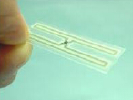Jan. 23, 2003 – Toppan Printing Co., the $10 billion Japanese printing, electronics and industrial products manufacturer is working with two other Japanese firms to mass produce readers that will cost less than $20, as well as RFID tags and labels that will cost about 50 cents each.
Toppan has signed agreements with Telemidic and Amplet. The companies will jointly develop radio frequency identification tags chips and readers that are compliant with the Auto-ID Center’s specifications.
Amplet, an engineering services company, has worked with Telemidic to develop a dual-frequency, small-scale, low-power RFID reader. Yoko Aikawa, a spokesperson for Toppan, told RFID Journal that the readers will cost about 2,000 yen initially, or about US$17. Aikawa did not provide details on how the company could produce a reader that costs about one twentieth of what many others on the market sell for today.
Telemidic is a subsidiary of NEC that holds patents for a read-write 2.45 GHz microchip that is approved for use under Japan’s strict laws governing the use of the radio spectrum. The chip can also operate at 915 MHz and will carry the Auto-ID Center’s Electronic Product Code (EPC).
Toppan plans to begin manufacturing the 2.45 GHz read-write RFID microchip and the reader this spring. The company says its goal is to achieve sales of 20 billion yen (US$170 million) this year and seize one-third of a market that is expected to reach 300 billion yen (US$2.5 billion) in 2005.
The company will sell finished smart labels, RFID inlays (the chip and antenna mounted on a thin substrate), and microchips. The chips will be compliant only with the Auto-ID Center’s specification and will be sold around the world by several large trading companies.
“At first, we will focus on brand protection, amusement parks and other markets that can support tags that cost in the middle range,” says Aikawa. “Within a few years, we will migrate the large-scale integration process itself to the logistics and source-tagging markets.”


